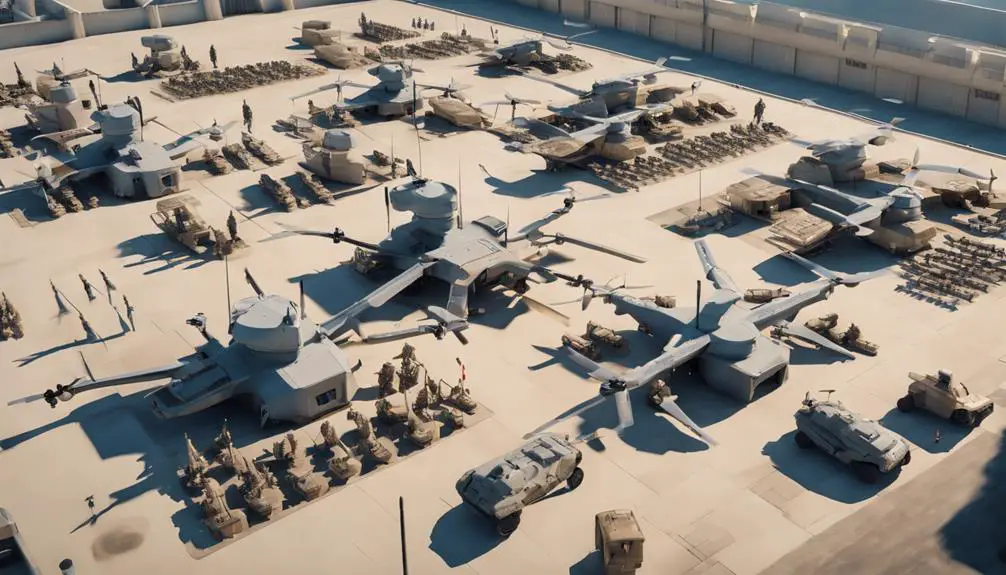Military drones come in various sizes, tailored for specific missions. Small tactical drones typically weigh under 20 pounds and are easily deployable, perfect for real-time intelligence. Medium reconnaissance drones range from 50 to 1,200 pounds, offering longer flight times and advanced surveillance capabilities. On the larger end, combat drones can exceed 10,000 pounds, equipped to carry heavy payloads and operate over vast distances. This size variety directly influences their roles in operations. If you're curious about how these different sizes affect their missions and effectiveness, there's more to uncover about their fascinating capabilities.
Overview of Military Drone Types
Military drones come in various types, each designed for specific missions and capabilities, so understanding their diversity is important. You'll find larger drones, like the MQ-9 Reaper, which excel in surveillance and precision strikes. These heavyweights can carry significant payloads and operate over long distances, offering strategic advantages. Then, there are medium-sized drones, often used for reconnaissance, providing essential intelligence without risking human lives. Smaller drones, while not our focus here, can be incredibly versatile for tactical operations. Each type plays an important role in modern warfare, enhancing operational effectiveness while minimizing risk to personnel. By grasping the big picture of military drone types, you can appreciate their impact on freedom and security in today's world.
Small Tactical Drones
Small tactical drones are increasingly utilized on the battlefield for real-time intelligence and surveillance, often providing commanders with essential situational awareness. These compact devices, typically weighing less than 20 pounds, can be deployed quickly and easily, allowing you to gather information without putting troops in harm's way. With advanced cameras and sensors, they capture high-resolution imagery and video, helping you make informed decisions. Their stealthy design enables them to operate in confined spaces and urban environments, where larger drones might struggle. By enhancing your ability to monitor enemy movements and assess threats, small tactical drones empower you to act decisively, ensuring that freedom and safety remain priorities in any conflict. Their effectiveness can truly redefine modern warfare.
Medium-Size Reconnaissance Drones
Medium-size reconnaissance drones bridge the gap between small tactical models and larger unmanned aerial vehicles, offering enhanced capabilities for gathering intelligence over extended ranges. These drones typically weigh between 50 to 1,200 pounds and can fly for several hours, making them ideal for surveillance missions without risking human lives. You'll appreciate their ability to navigate challenging environments while providing real-time data to decision-makers. Equipped with advanced sensors and imaging systems, they can capture high-resolution footage necessary for strategic planning. Their versatility means they can be deployed for various missions, from border patrol to disaster response. As you explore the potential of these drones, you'll find they empower freedom through informed decisions and enhanced situational awareness.
Large Combat Drones
Large combat drones take the capabilities of their medium-size counterparts to new heights, offering increased firepower and advanced targeting systems for engaging threats on the battlefield. These unmanned aerial vehicles (UAVs) can carry heavier payloads, including precision-guided munitions, making them formidable assets in modern warfare. You'll find that their longer flight times and greater ranges allow for sustained operations, giving you the ability to monitor and strike from a safe distance. The integration of cutting-edge technology enhances their situational awareness, ensuring that you can respond rapidly to emerging threats. As these drones evolve, they're becoming essential tools for maintaining freedom and security, empowering you to defend your values while minimizing risks to personnel on the ground.
Impact of Size on Operations
The size of military drones greatly influences their operational capabilities, affecting everything from payload capacity to maneuverability in various combat scenarios. When you consider the impact of a drone's size, keep in mind:
- Payload Capacity: Larger drones can carry heavier loads, allowing for more extensive weaponry or surveillance equipment.
- Maneuverability: Smaller drones often excel in tight spaces, making them ideal for urban warfare or reconnaissance.
- Stealth: Compact drones can evade radar more effectively, enhancing their ability to operate undetected.
- Flight Time: Bigger drones usually have more fuel capacity, extending their operational range and mission duration.
Understanding these factors can empower you to appreciate the strategic decisions made regarding drone deployment in pursuit of freedom and security.

